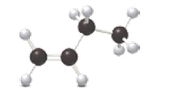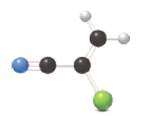
General, Organic, & Biological Chemistry
3rd Edition
ISBN: 9780073511245
Author: Janice Gorzynski Smith Dr.
Publisher: McGraw-Hill Education
expand_more
expand_more
format_list_bulleted
Question
Chapter 13, Problem 13.71P
Interpretation Introduction
(a)
Interpretation:
The polymer molecule should be identified by

Concept Introduction:
Interpretation Introduction
(b)
Interpretation:
The polymer molecule should be identified by polymerization of following compound:

Concept Introduction:
Alkenes are hydrocarbon molecules that consist a carbon-carbon double bond in the molecular.
Polymers are high molecular weight macromolecules which formed from covalently bonded monomer molecules.
Expert Solution & Answer
Want to see the full answer?
Check out a sample textbook solution
Students have asked these similar questions
For the titration of a divalent metal ion (M2+) with EDTA, the stoichiometry of the reaction is typically:
1:1 (one mole of EDTA per mole of metal ion)
2:1 (two moles of EDTA per mole of metal ion)
1:2 (one mole of EDTA per two moles of metal ion)
None of the above
Please help me solve this reaction.
Indicate the products obtained by mixing 2,2-dimethylpropanal with acetaldehyde and sodium ethoxide in ethanol.
Chapter 13 Solutions
General, Organic, & Biological Chemistry
Ch. 13.1 - Convert each condensed structure to a complete...Ch. 13.1 - Prob. 13.2PCh. 13.1 - Complete the structure of zingiberene, a component...Ch. 13.2 - Prob. 13.4PCh. 13.2 - Prob. 13.5PCh. 13.2 - Prob. 13.6PCh. 13.3 - Prob. 13.7PCh. 13.3 - Prob. 13.8PCh. 13.3 - Prob. 13.9PCh. 13.3 - Prob. 13.10P
Ch. 13.3 - Prob. 13.11PCh. 13.3 - Prob. 13.12PCh. 13.3 - Prob. 13.13PCh. 13.4 - Prob. 13.14PCh. 13.6 - Prob. 13.15PCh. 13.6 - Prob. 13.16PCh. 13.6 - Prob. 13.17PCh. 13.6 - Prob. 13.18PCh. 13.6 - Prob. 13.19PCh. 13.7 - Prob. 13.20PCh. 13.8 - Prob. 13.21PCh. 13.8 - Prob. 13.22PCh. 13.10 - Give the IUPAC name of each compound.
Ch. 13.10 - Prob. 13.24PCh. 13.11 - Prob. 13.25PCh. 13.12 - Prob. 13.26PCh. 13.13 - Prob. 13.27PCh. 13.13 - Prob. 13.28PCh. 13 - Anethole, the major constituent of anise oil, is...Ch. 13 - Prob. 13.30PCh. 13 - What is the molecular formula for a hydrocarbon...Ch. 13 - Prob. 13.32PCh. 13 - Prob. 13.33PCh. 13 - Prob. 13.34PCh. 13 - Prob. 13.35PCh. 13 - Prob. 13.36PCh. 13 - Give the IUPAC name for each molecule depicted in...Ch. 13 - Give the IUPAC name for each molecule depicted in...Ch. 13 - Give the IUPAC name for each compound. a....Ch. 13 - Give the IUPAC name for each compound. d....Ch. 13 - Prob. 13.41PCh. 13 - Prob. 13.42PCh. 13 - Give the structure corresponding to each IUPAC...Ch. 13 - Prob. 13.44PCh. 13 - Each of the following IUPAC names is incorrect....Ch. 13 - Each of the following IUPAC names is incorrect....Ch. 13 - Prob. 13.47PCh. 13 - Prob. 13.48PCh. 13 - Prob. 13.49PCh. 13 - Label the carbon-carbon double bond as cis or...Ch. 13 - Prob. 13.51PCh. 13 - Prob. 13.52PCh. 13 - Prob. 13.53PCh. 13 - Prob. 13.54PCh. 13 - Prob. 13.55PCh. 13 - Prob. 13.56PCh. 13 - Prob. 13.57PCh. 13 - Prob. 13.58PCh. 13 - Prob. 13.59PCh. 13 - Prob. 13.60PCh. 13 - What alkyd halide is formed when each alkene is...Ch. 13 - Prob. 13.62PCh. 13 - Prob. 13.63PCh. 13 - Prob. 13.64PCh. 13 - What alkene is needed as a starting material to...Ch. 13 - Prob. 13.66PCh. 13 - Prob. 13.67PCh. 13 - Prob. 13.68PCh. 13 - Prob. 13.69PCh. 13 - Prob. 13.70PCh. 13 - Prob. 13.71PCh. 13 - Prob. 13.72PCh. 13 - Prob. 13.73PCh. 13 - Prob. 13.74PCh. 13 - Prob. 13.75PCh. 13 - Prob. 13.76PCh. 13 - Prob. 13.77PCh. 13 - Prob. 13.78PCh. 13 - Prob. 13.79PCh. 13 - Prob. 13.80PCh. 13 - Prob. 13.81PCh. 13 - Are o-bromochlorobenzene and m-bromochlorobenzene...Ch. 13 - Give the structure corresponding to each IUPAC...Ch. 13 - Give the structure corresponding to each IUPAC...Ch. 13 - Prob. 13.85PCh. 13 - Prob. 13.86PCh. 13 - Prob. 13.87PCh. 13 - Prob. 13.88PCh. 13 - Prob. 13.89PCh. 13 - Prob. 13.90PCh. 13 - Prob. 13.91PCh. 13 - Prob. 13.92PCh. 13 - Prob. 13.93PCh. 13 - Eleostearic acid is an unsaturated fatty acid...Ch. 13 - Prob. 13.95PCh. 13 - Prob. 13.96PCh. 13 - Prob. 13.97PCh. 13 - Prob. 13.98PCh. 13 - Prob. 13.99PCh. 13 - Prob. 13.100PCh. 13 - Prob. 13.101PCh. 13 - Prob. 13.102PCh. 13 - Answer the following questions about compound A,...Ch. 13 - Prob. 13.104PCh. 13 - Prob. 13.105PCh. 13 - Prob. 13.106PCh. 13 - Prob. 13.107CPCh. 13 - Prob. 13.108CP
Knowledge Booster
Similar questions
- Synthesize 2-Ethyl-3-methyloxirane from dimethyl(propyl)sulfonium iodide using the necessary organic or inorganic reagents. Draw the structures of the compounds.arrow_forwardSynthesize 2-Hydroxy-2-phenylacetonitrile from phenylmethanol using the necessary organic or inorganic reagents. Draw the structures of the compounds.arrow_forwardSynthesize N-Methylcyclohexylamine from cyclohexanol using the necessary organic or inorganic reagents. Draw the structures of the compounds.arrow_forward
- Synthesize N-Methylcyclohexylamine from cyclohexanol using the necessary organic or inorganic reagents. Draw the structures of the compounds.arrow_forwardIf possible, please provide the formula of the compound 3,3-dimethylbut-2-enal.arrow_forwardSynthesize 1,4-dibromobenzene from acetanilide (N-phenylacetamide) using the necessary organic or inorganic reagents. Draw the structures of the compounds.arrow_forward
- Indicate the products obtained by mixing (3-oxo-3-phenylpropyl)triphenylphosphonium bromide with sodium hydride.arrow_forwardWe mix N-ethyl-2-hexanamine with excess methyl iodide and followed by heating with aqueous Ag2O. Indicate the major products obtained.arrow_forwardIndicate the products obtained by mixing acetophenone with iodine and NaOH.arrow_forward
- Indicate the products obtained by mixing 2-Propanone and ethyllithium and performing a subsequent acid hydrolysis.arrow_forwardIndicate the products obtained if (E)-2-butenal and 3-oxo-butanenitrile are mixed with sodium ethoxide in ethanol.arrow_forwardQuestion 3 (4 points), Draw a full arrow-pushing mechanism for the following reaction Please draw all structures clearly. Note that this intramolecular cyclization is analogous to the mechanism for halohydrin formation. COH Br + HBr Brarrow_forward
arrow_back_ios
SEE MORE QUESTIONS
arrow_forward_ios
Recommended textbooks for you
 Chemistry: Principles and PracticeChemistryISBN:9780534420123Author:Daniel L. Reger, Scott R. Goode, David W. Ball, Edward MercerPublisher:Cengage Learning
Chemistry: Principles and PracticeChemistryISBN:9780534420123Author:Daniel L. Reger, Scott R. Goode, David W. Ball, Edward MercerPublisher:Cengage Learning Chemistry: The Molecular ScienceChemistryISBN:9781285199047Author:John W. Moore, Conrad L. StanitskiPublisher:Cengage Learning
Chemistry: The Molecular ScienceChemistryISBN:9781285199047Author:John W. Moore, Conrad L. StanitskiPublisher:Cengage Learning ChemistryChemistryISBN:9781305957404Author:Steven S. Zumdahl, Susan A. Zumdahl, Donald J. DeCostePublisher:Cengage Learning
ChemistryChemistryISBN:9781305957404Author:Steven S. Zumdahl, Susan A. Zumdahl, Donald J. DeCostePublisher:Cengage Learning Chemistry: An Atoms First ApproachChemistryISBN:9781305079243Author:Steven S. Zumdahl, Susan A. ZumdahlPublisher:Cengage Learning
Chemistry: An Atoms First ApproachChemistryISBN:9781305079243Author:Steven S. Zumdahl, Susan A. ZumdahlPublisher:Cengage Learning

Chemistry: Principles and Practice
Chemistry
ISBN:9780534420123
Author:Daniel L. Reger, Scott R. Goode, David W. Ball, Edward Mercer
Publisher:Cengage Learning

Chemistry: The Molecular Science
Chemistry
ISBN:9781285199047
Author:John W. Moore, Conrad L. Stanitski
Publisher:Cengage Learning

Chemistry
Chemistry
ISBN:9781305957404
Author:Steven S. Zumdahl, Susan A. Zumdahl, Donald J. DeCoste
Publisher:Cengage Learning

Chemistry: An Atoms First Approach
Chemistry
ISBN:9781305079243
Author:Steven S. Zumdahl, Susan A. Zumdahl
Publisher:Cengage Learning

